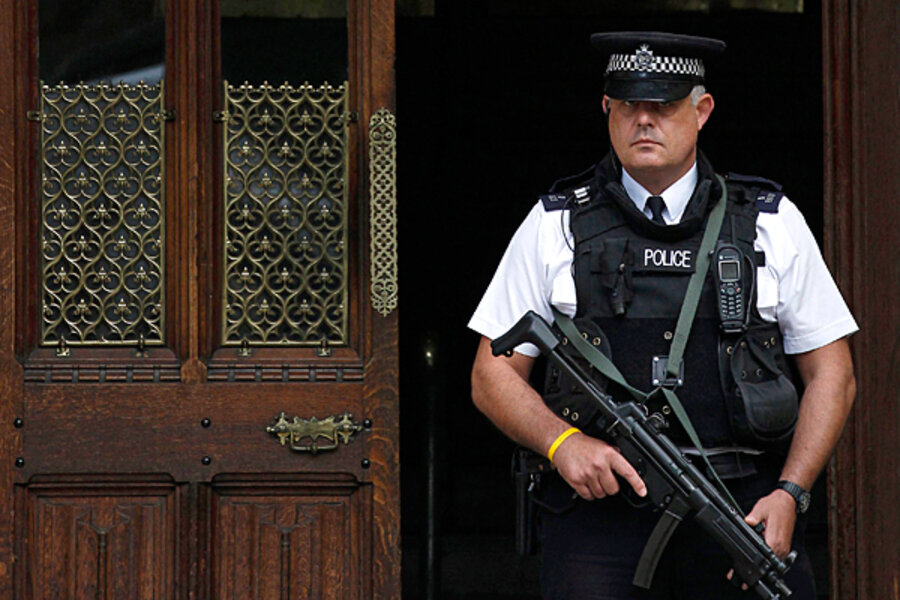Was a Mumbai-style terror attack really 'foiled'?
Loading...
Breathless coverage in the past few days has written at length about a potential "Mumbai-style" terror attack planned for Britain – or perhaps Germany, or France – that was thwarted by the Obama administration's expanding aerial campaign against militant targets in Pakistan's lawless border provinces.
The reference to Mumbai is to the 10 militants who roamed the city's Taj Mahal Hotel, rail station, and other locations for hours two years ago, murdering 168 people and raising serious questions about the competence of India's security forces.
Many newspapers carried photographs of the Mumbai attackers in action in their stories on the revelation of the plot – which is said to have been disrupted when a US drone strike in Pakistan's North Waziristan killed a British national and alleged plotter on Sept. 8.
While those pictures and references to Mumbai conjured fears of similar carnage in London – where 52 citizens and four militants died in subway bombings in 2005 – what's become clear over the past few days that such an attack was far from being realized.
In fact, the "threat" to European capitals today is probably about what it's been every day for the past few years -- and is much lower than, say, a decade ago, when there was less of an intelligence effort devoted to monitoring and disrupting these kinds of plots. That's confirmed by the British and German decision not to elevate their estimation of the "threat" level inside their countries.
There has not been a successful major attack by Islamic militants in Europe since the London bombings of 2005 and in the US since Sept. 11, 2001.
That second may be arguable, since Army Major Nidal Malik Hassan, who murdered 12 of his comrades at Ft. Hood late last year, was inspired by Al Qaeda fellow traveler Anwar al Awlaki, a Yemen-based cleric and US national. But all indications so far was that he was acting alone.
The evacuation of the Eiffel Tower yesterday appears to be unconnected, since that was prompted by a phoned in bomb threat. Militants inspired by Al Qaeda rarely provide those kinds of warnings and, in any event, no bombs were found at the tourist attraction.
The anonymous government officials discussing the issue in the press have used words like "preliminary" and "immature" in describing the plot, and Western intelligence officials have been on to the aspirations of a group of two British and eight German Muslims in a North Waziristan camp at least since a confederate of theirs was arrested in Afghanistan in July. If a plan in Europe were anywhere close to fruition, an air strike in Waziristan would be of little utility.
The information provided by that man was probably more important to disrupting their intentions than the actual drone strike, one of about 20 carried out so far this month in Pakistan. President Obama has stepped up an assassination campaign inside that country, whose intelligence agency tolerates and occasionally provides assistance to militants crossing the border to attack NATO and Afghan forces.
An unidentified Pakistani official told the Associated Press today that the surviving would-be attackers are under telephone and electronic surveillance, that the killed Briton was named Abdul Jabbar, and that they were a long way from carrying out an attack.
"They have been making calls to Germany and London," he told the AP. "They have been talking about and looking for facilitators and logistics they need there to carry out terror strikes.”
That implies that they did not yet have access to the automatic weapons and grenades inside Europe needed to carry out a terror attack.
And while the officials have said that three countries were targeted, it appears that the unsophisticated plan was in such early stages that it almost certainly would have changed, based on the availability of weapons and willing accomplices. So far, no evidence has been found that the Pakistan-based group have found any accomplices in any of the targeted countries.
To be sure, European governments and the US have long been aware of a trickle of young nationals heading off to training camps in Pakistan, mostly first- and second-generation immigrants from Pakistan and other Muslim countries, but occasionally young converts like Adam Gadahn, who helps make propaganda videos in English for Al Qaeda in Pakistan.
The so-called Time Square bomber Faisal Shahzad, whose car-bomb failed to explode and is awaiting sentencing in a New York court, received some training in Pakistan. The failed 2006 plan to destroy airliners originating in London with liquid explosives involved both immigrants from Pakistan and English converts who had traveled to Pakistan.
The long-term concern that militant young men with some military skills will one day return home from Pakistan – much as the so-called "Afghan Arabs" returned to Saudi Arabia, Egypt, and other Muslim countries after battling the Soviets in Afghanistan, bringing terrorism home with them – is likely to keep the US bombing campaign humming along in Pakistan.
While the drone attacks may be unpopular with the Pakistani people – and a cross-border raid by US forces using helicopters drew a sharp response from Pakistan this week – there are no signs of a pullback from the American air-campaign over Pakistan.





